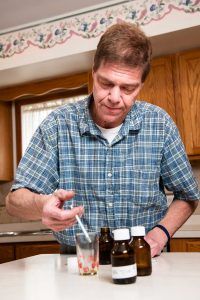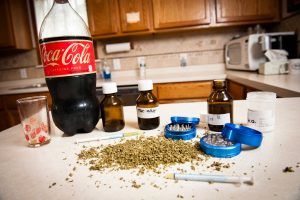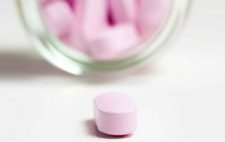The recreational drug that many say can heal serious health conditions has stirred quite a debate across the country. Supporters say let the drug do its magic. Medical doctors argue they need more research. And conservatives scoff at even the notion of giving pot to kids. But while the public debates and policies flounder, many families in South Jersey are simply doing what they must to save their children.

Genny Barbour
Maple Shade residents Roger and Lora Barbour are not pharmacists. Yet once a month, their kitchen turns into a makeshift lab. This is where they extract the active ingredients from marijuana – purchased in its dried form – and turn it into an oil extract. As an edible, medical marijuana has been little short of a miracle treatment for their 16-year-old daughter Genny, a happy child with a singsong voice who has suffered from epilepsy since she was 3 months old.
Until they tried marijuana, any and all treatments prescribed to curtail Genny’s severe seizures – including narcotic drugs, brain surgery and restrictive diets – not only failed, they often produced dangerous side effects.
On a recent cooking day, the unmistakably pungent smell of pot lofts through the air as Roger grinds up a half-ounce of cannabis bud. Next, he puts it in the oven to bake for 30 minutes. This, Lora explains, activates the plant’s therapeutic properties.
“The strain we’re making today is one high in CBD and low in TCH,” says Lora, using the acronyms for cannabidiol, believed to have medicinal properties, and tetrahydrocannabinol, the psychoactive ingredient. “It is a hippy reject. You cannot buy it on the street, and you cannot get high on it.”

Roger Barbour
The third and final step entails combining the cannabis with coconut oil that’s been heated in a Crock Pot. The entire process takes five hours. This strain, combined with two others made the same way, comprises the medicine they mix into cola to give to Genny four times a day. The marijuana costs $535 per ounce, not including taxes. It can’t be purchased at a pharmacy; Lora must make an hour-and-a-half road trip to the Alternative Care Dispensary in Woodbridge each month to buy it. As for their recipe, it’s culled from the advice of other moms of sick kids connected on Facebook, recipes on the Internet, and trial and error.
It’s a time-consuming and expensive process, but for the Barbours and other parents using cannabis to help their sick children, there is no legal alternative short of moving to a state with less restrictive pot policies. Nearly two years after Gov. Chris Christie signed a law allowing children to consume marijuana-infused medical products, the promised oils, syrups or lozenges have yet to come on the market. It is just one of the many roadblocks that critics of the state’s medical marijuana law say make obtaining the legalized medicine onerous for patients and particularly the parents of sick children.
“The marijuana available at New Jersey’s Alternative Treatment Centers is among the most expensive in the country,” notes Ken Wolski, executive director of the New Jersey Coalition for Medical Marijuana. “Then it’s not even in a form that parents can use. The law to make edible products available was passed back in 2012. Here it is in 2015, and they’re still not here.”
New Jersey’s Compassionate Use Marijuana Act, passed in 2010, is considered the most restrictive and expensive in the nation, says Wolski. Although anticipated to serve tens of thousands of patients at its advent, the costs and multiple steps to register for the Medical Marijuana Program (MMP), as well as the limited conditions for which it is approved for treatment, have elminated many potential recipients. There are currently 4,781 patients registered in MMP, according to the New Jersey Health Department. Citing confidentiality, the department would not release the number of patients under the age of 18.
Fees run from the $200 charge for a two-year registration card to the price of doctor visits that insurance won’t cover to the price of the pot itself, which averages $500 per ounce and is then taxed at 7 percent by the state, according to Wolski.
For minors, the process is even more cumbersome. While adults need approval from one doctor, kids must have consent from two to three doctors: beginning with a pediatrician and a psychiatrist. If neither is registered with the program – and currently only 29 physicians have certified minor patients, including 2 pediatricians – an additional physician also must sign off.
Among the conditions eligible for treatment under the program, which include end-stage cancer, glaucoma and muscular dystrophy, epilepsy has been the most high profile. Pot’s potential for helping children control seizures has been widely publicized.
In a 2013 CNN special called “Weed,” Chief Medical Correspondent Dr. Sanjay Gupta chronicled the story of Charlotte Figi, a Colorado child with Dravet syndrome, a severe form of early-onset epilepsy. When Charlotte started cannabis treatment at age 5, she went from having 300 seizures a week and being unable to walk to having only one or two seizures a week, according to the documentary. The cannabis oil that worked miracles for her was named Charlotte’s Web in her honor. Since the story aired, hundreds of “medical marijuana refugees” have moved to Colorado, where the oil is legal and affordable. Moreover, a majority of New Jerseyans support legalizing, taxing and regulating marijuana for recreational use by adults 21 and over, according to a Rutgers-Eagleton poll released this past summer.
In New Jersey, a small but vocal community of parents of sick children is fighting to make marijuana more accessible and cheaper for patients. Yet other residents – tired of the struggle, expense and need to make their own medicine without the support of pharmacists or doctors – have uprooted their lives and moved out West. Still more take their chances with the law, transporting marijuana across state lines or buying it on the black market for their children’s treatment, an act prohibited in New Jersey and subject to criminal charges, even if the pot is used for medical purposes.
Woodlynne resident Ricardo Rivera, whose 8-year-old daughter Tuffy suffers from Lennox-Gastaut Syndrome, one of the rarest and most severe forms of epilepsy, has stuck it out so far, making the cannabis oil that has reduced Tuffy’s seizures by 95 percent. But he fears his family can’t wait much longer for New Jersey to reform its policies.
Although young Tuffy has made incredible strides, Rivera works long hours to afford the medicine that would be a fraction of the price in Colorado.
“It’s ridiculous that my daughter has a condition in which the average life span is nine years and it took a year-and-a-half to get the [MMP] card,” says Rivera, who took a fact-finding tour to Denver in the spring but hopes his family doesn’t have to move.
“I’m being forced to work overtime every day to afford the marijuana. She qualifies for two ounces, but we can’t afford to buy two, so we try to make it stretch as much as possible.”

The Barbours pay $535 each month for the marijuana needed for their daughter’s care
It isn’t supposed to be this hard to get medical marijuana in a state where it’s legal, advocates charge. Since 1996, when California became the first state to allow medical marijuana use, it has become legal in 20 states, the District of Columbia and Guam. Of the 20, four made pot legal for recreational use. Fourteen states have passed more narrow legislation allowing limited access to low tetrahydrocannabinol (THC), high cannabidiol (CBD) products for medical reasons, according to the National Conference of State Legislatures.
Critics say there are several layers of complications in the quest to obtain medical marijuana. Foremost, cannabis (the drug produced from the Cannabis sativa or Cannabis indica plant) has been classified as a Schedule 1 drug since 1970 by an act of Congress. In the same classification of heroin, LSD and ecstasy, it is considered a dangerous substance that has no recognizable medical use and a high potential for abuse, making the distribution of marijuana a federal offense. The classification, experts say, has had both political and medical ramifications.
On the education front, New Jersey’s drug and violence prevention curriculum still mandates that educators address marijuana as a drug that can be misused, stresses Nick De Mauro, executive director of Law Enforcement Against Drugs (L.E.A.D), which recently replaced D.A.R.E. in New Jersey classrooms.
DeMauro, a former N.J. police detective, says, if anything, the legalization and medical marijuana movements are making the job of teaching about substance abuse even harder by clouding the issues.
“Like any other prescription drug, marijuana can be misused,” he says, noting that Percoset and Oxycodone are both prescription drugs that are highly addictive. “The intensity of a specific drug or its medical use is almost irrelevant.”
Even as doctors and researchers have long suspected that some compounds in marijuana effectively treat epilepsy and other hard-to-cure conditions, independent clinical trials with human subjects are scarce and require approval from federal agencies. The lack of research presents serious challenges: without much scientific study of marijuana, the government has been unwilling to reclassify the drug. But the categorization as a Schedule 1 drug makes testing it on humans – let alone children – extremely difficult.
Pediatric neurologist Michael Goodman, MD, says he believes in the potential of marijuana based on evidence of successes in treating epilepsy and other ailments dating back thousands of years. He has also followed with great interest the high-profile reports of how some children have had “almost magical” responses to cannabis oil. Still, he says, further studies are needed before he would feel comfortable prescribing it to children.
“The problem I see is that marijuana is, as a plant, a very complex structure,” says Goodman, chairman and chief of the department of pediatrics at Cooper University Health Care.
“Marijuana is made up of hundreds of different substances, and there are many sites where it binds to receptors, creating different kinds of activities in the brain. This is why doctors and scientists really want to isolate something as clean as possible to study, understand and replicate.”
Even with the two most widely studied strains, CBD and THC, there is not enough information to conclude the ratio in which those two substances would combine most effectively to treat different maladies and whether – like grapes used for wine – different geographic regions and growing conditions produce different compositions of the substance, Goodman says. And there are scant studies on the most effective mode of delivery of the drug to the body and how prolonged use of cannabis would affect the developing brain of a 12-year-old, let alone a 5-year-old or toddler.
“I am a firm believer that plants are a resource for medications, and I’m confident that we’re going to be able to identify the substances or substance from marijuana for effective medications,” he says. “But the doctor in me and the scientist in me does not feel all questions are answered on this topic, which makes medical marijuana very difficult to prescribe at this time.”
He adds that while he does not know of any pediatric neurologists who prescribe medical marijuana, he has made recommendations to patients to seek out doctors who are willing to do so.
Beyond the medical questions, there’s the politics. New Jersey’s MMP was signed into law by then-Gov. Jon Corzine during his final days in Trenton. Upon inheriting it, Gov. Christie eliminated the provision allowing for edibles. He has been outspoken about his reluctance to ease restrictions, describing medical marijuana on many occasions as a back door to recreational pot.
In 2013, Scotch Plains father Brian Wilson made national headlines when he confronted Christie at a diner, asking him to sign a pending marijuana reform bill and pleading, “Please don’t let my daughter die.” Not long after the confrontation, Christie signed a compromise bill that allowed multiple strains of cannabis to be grown and made into edible form, but for children only.
However, none of the four previously sanctioned dispensaries in the state are producing edible products. In March – 18 months after the law was signed – the state released standards for the growers who will be manufacturing the oils and other edibles. However, there is no timetable for when they will be on the market.
Several bills have been proposed to reform the MMP, including provisions allowing edibles for adults, adding to the number of medical conditions that qualify for treatment and removing the requirement that minors must have a psychiatric evaluation. However, lawmakers are not optimistic that Christie will sign them into law. Several families who have been very public in the fight to reform the law got tired of waiting and left the state. This includes the Wilsons, who last year moved to Denver where their daughter Vivian is being treated with cannabis oil for Dravet Syndrome.
“We’re not hopeful for reform while Gov. Christie is in office,” says Wolski. “He’s made it quite clear he’s opposed to any type of marijuana reform.”
Still, some progress has been made: in June the state Health Department issued a permit for a fifth medical marijuana dispensary expected to open in Bellmawr this month. Meanwhile, several of the dispensaries are pursuing plans to manufacture edibles. Compassionate Sciences Inc, which will manage the new South Jersey dispensary, has already planted its clones and is awaiting its first harvest, says Compassionate Sciences spokesman Andrei Bogolubov. He says the business expects to be open for operation shortly after Labor Day (following final state approval) and plans to apply to the state to make edibles.
“We do have expertise in this area and can set up and get [the manufacture of edibles] going very quickly,” says Bogolubov, noting that the company runs dispensaries in other states as well as a testing and analytics safety potency lab in Denver, Colorado. “We have the technology to really do it right and deliver, particularly for epilepsy applications.”
If and when medical marijuana is available in edible form, there are still other major impediments facing medical marijuana users, particularly children.
Take Genny Barbour. Although marijuana has been transformative in her young life, her treatment is compromised by the fact that she is not permitted to have her doctor-ordered lunchtime dose of medicine at school, according to her parents. After the school refused to give her the medicine, saying it’s illegal for them to administer it because marijuana is still illegal under federal law, the Barbours sued the Maple Shade School District. The story went viral, gaining momentum after “People” magazine featured their plight in May.
Acting as his daughter’s lawyer, Roger Barbour, an attorney, argued that Genny needs her dose to make it through a day of classes at the Larc School in Bellmawr, a private school for children with developmental disabilities. When her morning dose wears off, she becomes so distressed that her teachers often have to restrain her. Barbour has numerous pictures of the bruises and welts his daughter has sustained trying to fight the restraints. It is part of his evidence book for court use.
Barbour was unsuccessful in his first and second round: Administrative Law Judge John S. Kennedy ruled in January that the state’s Drug Free School Act and Federal law are in conflict with the state’s marijuana law. He sided with the school. Following an appeal, Kennedy reaffirmed his decision last month.
For the time being, the Barbours only have Genny in school half a day, so she is able to have her lunchtime dose administered at home. Barbour says he and Lora are prepared to take this fight to the U.S. Supreme Court if necessary. Meanwhile, a bill introduced by Assemblywoman Pamela Lampitt and Assemblyman Lou Greenwald, (both D-Camden) requiring school districts to develop cannabis policies for students who are registered with the state’s program is gaining traction. However, they are not optimistic that Christie would sign it into law.
“Before, she was a zombie,” says Lora, describing Genny before she began taking medical marijuana. “They had her so high on pharmaceuticals that never helped her. They never stopped a single seizure. She lost body weight and lost her period, because the drugs were so toxic. But never on pot. And people worry about her being high?”









